Research on the Method of Extracting Water Body Information in Central Asia Based on Google Earth Engine
Abstract
:1. Introduction
2. Materials and Methods
2.1. Study Area and Study Period
2.1.1. Remote Sensing Image Data Sources
2.1.2. Other Auxiliary Data
2.2. Research Methods
2.2.1. Modified Normalized Difference Water Index
2.2.2. The Maximum Inter-Class Variance Algorithm
2.2.3. Random Forest Algorithm
2.2.4. Pearson Correlation
2.3. Research Process
2.4. Accuracy Verification
3. Results and Analysis
3.1. Extraction Results of Water Bodies in Five Central Asian Countries
3.1.1. Algorithm Extraction Effect
3.1.2. Water Bodies in Central Asian Countries Change Year by Year
3.2. Analysis of Typical Water Extraction Results
3.2.1. Analysis of the Extraction Results of Water Bodies in the Aral Sea Area
3.2.2. Analysis of the Results of Glacier Extraction in Southern Kyrgyzstan
3.3. Accuracy Verification of Water Extraction Results
4. Discussion
4.1. Data Analysis and Discussion
- (1)
- Low-temperature suppression of evaporation in high-altitude areas
- (2)
- Less interference from human activities
- (3)
- Main types of water bodies and types of water recharge
4.2. The Relevant Contributions of This Study
4.3. Limitations of This Study
5. Conclusions
- (1)
- The Effectiveness of Extraction Methods: The random forest algorithm outperformed both the MNDWI and the OTSU in terms of overall accuracy and kappa coefficient, achieving 95.21% accuracy and a kappa coefficient of 90.29%. While the MNDWI method showed the highest accuracy (97.14%) and kappa coefficient (94.21%), these values were likely inflated due to the manual visual interpretation process, which can introduce subjective biases. The MNDWI method also struggled with accurately identifying seasonal water bodies and areas affected by permanent water degradation. In contrast, the random forest algorithm excelled in edge smoothing and the extraction of small water bodies, making it the most effective method for water body extraction in Central Asia.
- (2)
- Climate-Driven Water Loss: The study revealed a strong correlation between climate variables and water body area changes in Central Asia. The Pearson correlation coefficients indicated that rising temperatures (−0.5583) and declining precipitation (0.6872) are key drivers of water loss in the region. Over the 20-year study period (2000–2019), the average annual temperature in Central Asia exhibited a fluctuating upward trend, while precipitation showed a fluctuating downward trend. These climatic changes align with the observed 11.25% reduction in the total water body area across the region.
- (3)
- Regional Water Body Changes: The analysis highlighted significant regional variations in water body changes. The Aral Sea, for instance, experienced a dramatic 72.13% reduction in its water area, with the East Aral Sea shrinking by 93.3% from 2003 to 2019. Similarly, glaciers in southern Kyrgyzstan decreased by 39.23% over the same period. These changes underscore the vulnerability of Central Asia’s water resources to both climatic and anthropogenic pressures.
- (4)
- Implications for Water Resource Management: The findings emphasize the urgent need for adaptive water resource management strategies in Central Asia, particularly in light of the region’s increasing vulnerability to climate change. The RF-GEE framework proved to be an effective tool for large-scale, long-term hydrological monitoring, offering critical insights for climate resilience planning. Future research should focus on expanding the temporal scope of analysis and incorporating additional data sources to further enhance the accuracy and comprehensiveness of water body extraction in arid and semi-arid regions.
Author Contributions
Funding
Data Availability Statement
Conflicts of Interest
References
- Bi, X.; Chang, B.; Hou, F.; Yang, Z.; Fu, Q.; Li, B. Assessment of Spatio-Temporal Variation and Driving Mechanism of Ecological Environment Quality in the Arid Regions of Central Asia, Xinjiang. Int. J. Environ. Res. Public Health 2021, 18, 7111. [Google Scholar] [CrossRef]
- Li, J.; Chen, X.; Bao, A. Spatial-temporal characteristics of lake level changes in central Asia during 2003–2009. Acta Geogr. Sin. 2011, 66, 1219–1229. [Google Scholar]
- Mueller, L.; Suleimenov, M.; Karimov, A.; Qadir, M.; Saparov, A.; Balgabayev, N.; Helming, K.; Lischeid, G. Land and Water Resources of Central Asia, Their Utilisation and Ecological Status. In Novel Measurement and Assessment Tools for Monitoring and Management of Land and Water Resources in Agricultural Landscapes of Central Asia; Mueller, L., Saparov, A., Lischeid, G., Eds.; Springer International Publishing: Cham, Switzerland, 2014; pp. 3–59. [Google Scholar]
- Peng, D.; Zhou, T.; Zhang, L. Moisture Sources Associated with Precipitation during Dry and Wet Seasons over Central Asia. J. Clim. 2020, 33, 10755–10771. [Google Scholar] [CrossRef]
- Xia, Q.-Q.; Chen, Y.-N.; Zhang, X.-Q.; Ding, J.-L. Spatiotemporal Changes in Ecological Quality and Its Associated Driving Factors in Central Asia. Remote Sens. 2022, 14, 3500. [Google Scholar] [CrossRef]
- Cheng, C.; Fu, W.; Hu, Z.; Li, X. Changes of major lakes in Central Asia over the past 30 years revealed by remote sensing technology. Remote Sens. Land Resour. 2015, 27, 146–152. [Google Scholar]
- Kandekar, V.U.; Pande, C.B.; Rajesh, J.; Atre, A.; Gorantiwar, S.; Kadam, S.; Gavit, B. Surface water dynamics analysis based on sentinel imagery and Google Earth Engine Platform: A case study of Jayakwadi dam. Sustain. Water Resour. Manag. 2021, 7, 44. [Google Scholar] [CrossRef]
- Deng, Y.; Jiang, W.; Tang, Z.; Ling, Z.; Wu, Z. Long-Term Changes of Open-Surface Water Bodies in the Yangtze River Basin Based on the Google Earth Engine Cloud Platform. Remote Sens. 2019, 11, 2213. [Google Scholar] [CrossRef]
- Wang, C.; Jia, M.; Chen, N.; Wang, W. Long-Term Surface Water Dynamics Analysis Based on Landsat Imagery and the Google Earth Engine Platform: A Case Study in the Middle Yangtze River Basin. Remote Sens. 2018, 10, 1635. [Google Scholar] [CrossRef]
- Gorelick, N.; Hancher, M.; Dixon, M.; Ilyushchenko, S.; Thau, D.; Moore, R. Google Earth Engine: Planetary-scale geospatial analysis for everyone. Remote Sens. Environ. 2017, 202, 18–27. [Google Scholar] [CrossRef]
- Cheng, W.; Qian, X.; Li, S.; Ma, H.; Liu, D.; Liu, F.; Liang, J.; Hu, J. Research and application of PIE-Engine Studio for spatiotemporal remote sensing cloud computing platform. Natl. Remote Sens. Bull. 2022, 26, 335–347. [Google Scholar] [CrossRef]
- Fu, D.; Xiao, H.; Su, F.; Zhou, C.; Dong, J.; Zeng, Y.; Yan, K.; Li, S.; Wu, J.; Wu, W.; et al. Remote sensing cloud computing platform development and Earth science application. Natl. Remote Sens. Bull. 2021, 25, 220–230. [Google Scholar] [CrossRef]
- Jintao, L.; Chao, C.; Weiwei, S.; Gang, Y.; Zhisong, L.; Zili, Z. Spatio-temporal land use/cover change dynamics in Hangzhou Bay, China, using long-term Landsat time series and GEE platform. Natl. Remote Sens. Bull. 2023, 27, 1480–1495. [Google Scholar]
- Sheng, X.; Cao, Y.; Zhou, W.; Cheng, L.; Zhang, H.; Planning, R. Impact of land use change on ecosystem service value in Beijing-Tianjin-Hebei region. Chin. J. Agric. Resour. 2018, 39, 79–86. [Google Scholar]
- Shelestov, A.; Lavreniuk, M.; Kussul, N.; Novikov, A.; Skakun, S. Exploring Google Earth Engine Platform for Big Data Processing: Classification of Multi-Temporal Satellite Imagery for Crop Mapping. Front. Earth Sci. 2017, 5, 17. [Google Scholar] [CrossRef]
- Yan, K.; Chen, H.; Fu, D.; Zeng, Y.; Dong, J.; Li, S.; Wu, Q.; Li, H.; Du, S. Bibliometric visualization analysis related to remote sensing cloud computing platforms. Natl. Remote Sens. Bull. 2022, 26, 310–323. [Google Scholar] [CrossRef]
- Deng, H.; Chen, Y.; Wang, H.; Zhang, S. Climate change with elevation and its potential impact on water resources in the Tianshan Mountains, Central Asia. Glob. Planet. Change 2015, 135, 28–37. [Google Scholar] [CrossRef]
- Ali, M.I.; Dirawan, G.D.; Hasim, A.H.; Abidin, M.R. Detection of changes in surface water bodies urban area with NDWI and MNDWI methods. Int. J. Adv. Sci. Eng. Inf. Technol. 2019, 9, 946–951. [Google Scholar] [CrossRef]
- Xu, Q. Research on extracting water information using improved normalized difference water index (MNDWI). J. Remote Sens. 2005, 9, 589–595. [Google Scholar]
- Otsu, N. A threshold selection method from gray-level histograms. Automatica 1975, 11, 23–27. [Google Scholar] [CrossRef]
- Breiman, L. Random forests. Mach. Learn. 2001, 45, 5–32. [Google Scholar] [CrossRef]
- Cutler, A.; Cutler, D.R.; Stevens, J.R. Random forests. In Ensemble Machine Learning: Methods; Springer: New York, NY, USA, 2012; pp. 157–175. [Google Scholar]
- Rigatti, S.J. Random forest. J. Insur. Med. 2017, 47, 31–39. [Google Scholar] [CrossRef] [PubMed]
- Du, P.; Xu, M.; Li, R. Impacts of climate change on water resources in the major countries along the Belt and Road. PeerJ 2021, 9, e12201. [Google Scholar] [CrossRef] [PubMed]
- Rodell, M.; Houser, P.R.; Jambor, U.E.A.; Gottschalck, J.; Mitchell, K.; Meng, C.J.; Arsenault, K.; Cosgrove, B.; Radakovich, J.; Bosilovich, M.; et al. The global land data assimilation system. Bull. Am. Meteorol. Soc. 2004, 85, 381–394. [Google Scholar] [CrossRef]
- Funk, C.; Peterson, P.; Landsfeld, M.; Pedreros, D.; Verdin, J.; Shukla, S.; Husak, G.; Rowland, J.; Harrison, L.; Hoell, A.; et al. The climate hazards infrared precipitation with stations—A new environmental record for monitoring extremes. Sci. Data 2015, 2, 150066. [Google Scholar] [CrossRef]
- Gao, B.-C. NDWI—A normalized difference water index for remote sensing of vegetation liquid water from space. Remote Sens. Environ. 1996, 58, 257–266. [Google Scholar] [CrossRef]
- Hastie, T.; Tibshirani, R.; Friedman, J.; Hastie, T.; Tibshirani, R.; Friedman, J. Random forests. In The Elements of Statistical Learning: Data Mining, Inference, Prediction; Springer: New York, NY, USA, 2009; pp. 587–604. [Google Scholar]
- Huang, S.; Chen, X.; Ma, X.; Fang, H.; Liu, T.; Kurban, A.; Guo, J.; De Maeyer, P.; Van de Voorde, T. Monitoring surface water area changes in the aral sea basin using the Google Earth engine cloud platform. Water 2023, 15, 1729. [Google Scholar] [CrossRef]
- Osmonov, A.; Bolch, T.; Xi, C.; Kurban, A.; Guo, W. Glacier characteristics and changes in the Sary-Jaz River Basin (Central Tien Shan, Kyrgyzstan)–1990–2010. Remote Sens. Lett. 2013, 4, 725–734. [Google Scholar] [CrossRef]
- Yang, X.; Wang, N.; He, J.; Hua, T.; Qie, Y. Changes in area and water volume of the Aral Sea in the arid Central Asia over the period of 1960–2018 and their causes. Catena 2020, 191, 104566. [Google Scholar] [CrossRef]
- Wang, X.; Chen, Y.; Li, Z.; Fang, G.; Wang, F.; Liu, H. The impact of climate change and human activities on the Aral Sea Basin over the past 50 years. Atmos. Res. 2020, 245, 105125. [Google Scholar] [CrossRef]
- Huang, W.; Duan, W.; Chen, Y. Rapidly declining surface and terrestrial water resources in Central Asia driven by socio-economic and climatic changes. Sci. Total Environ. 2021, 784, 147193. [Google Scholar] [CrossRef]
- Xia, X.; Wu, Q.; Mou, X.; Lai, Y. Potential impacts of climate change on the water quality of different water bodies. J. Environ. Inf. 2015, 25, 85–98. [Google Scholar] [CrossRef]
- Klein, I.; Dietz, A.J.; Gessner, U.; Galayeva, A.; Myrzakhmetov, A.; Kuenzer, C. Evaluation of seasonal water body extents in Central Asia over the past 27 years derived from medium-resolution remote sensing data. Int. J. Appl. Earth Obs. Geoinf. 2014, 26, 335–349. [Google Scholar] [CrossRef]
- Fallah, B.; Didovets, I.; Rostami, M.; Hamidi, M. Climate change impacts on Central Asia: Trends, extremes and future projections. Int. J. Climatol. 2024, 44, 3191–3213. [Google Scholar] [CrossRef]

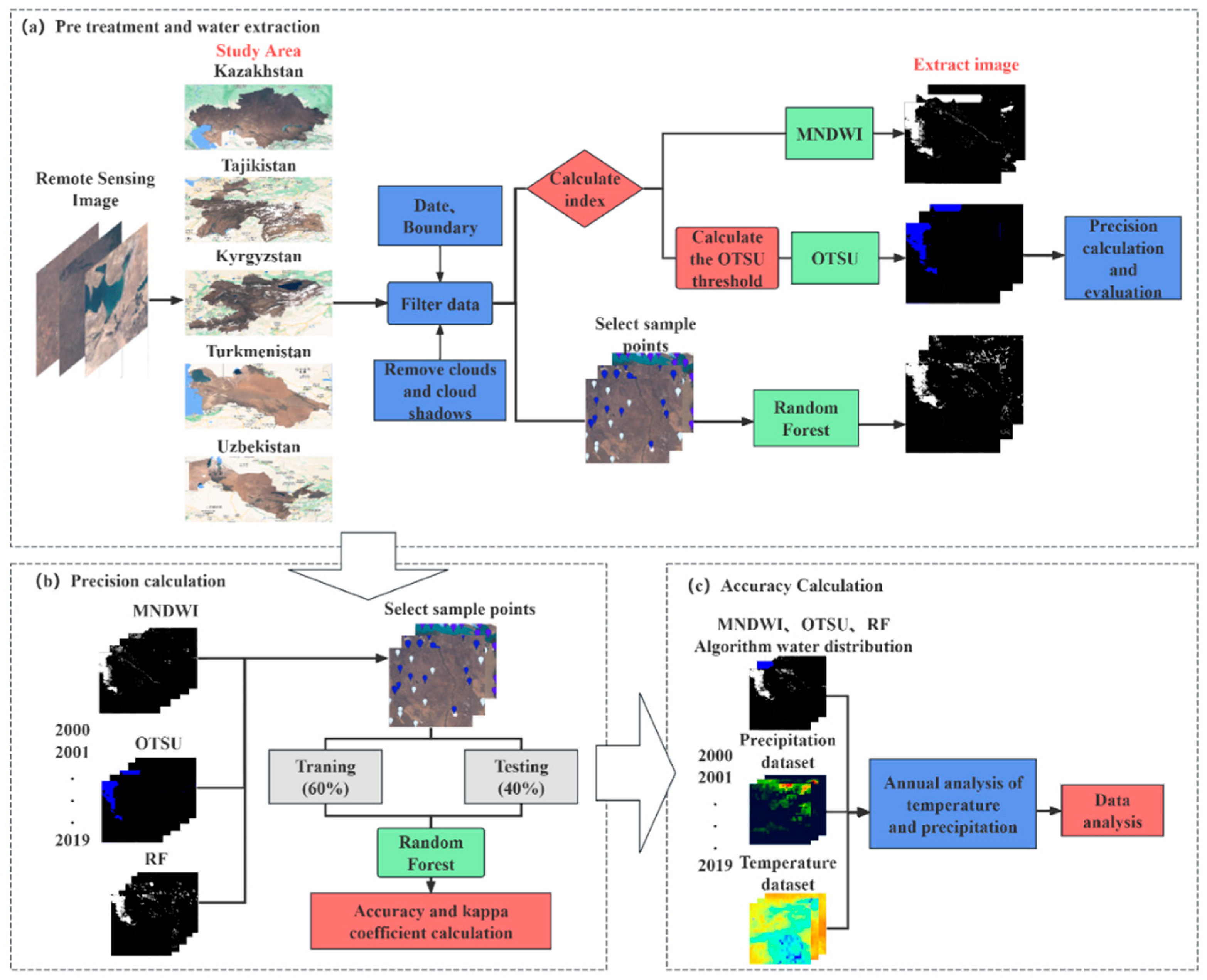

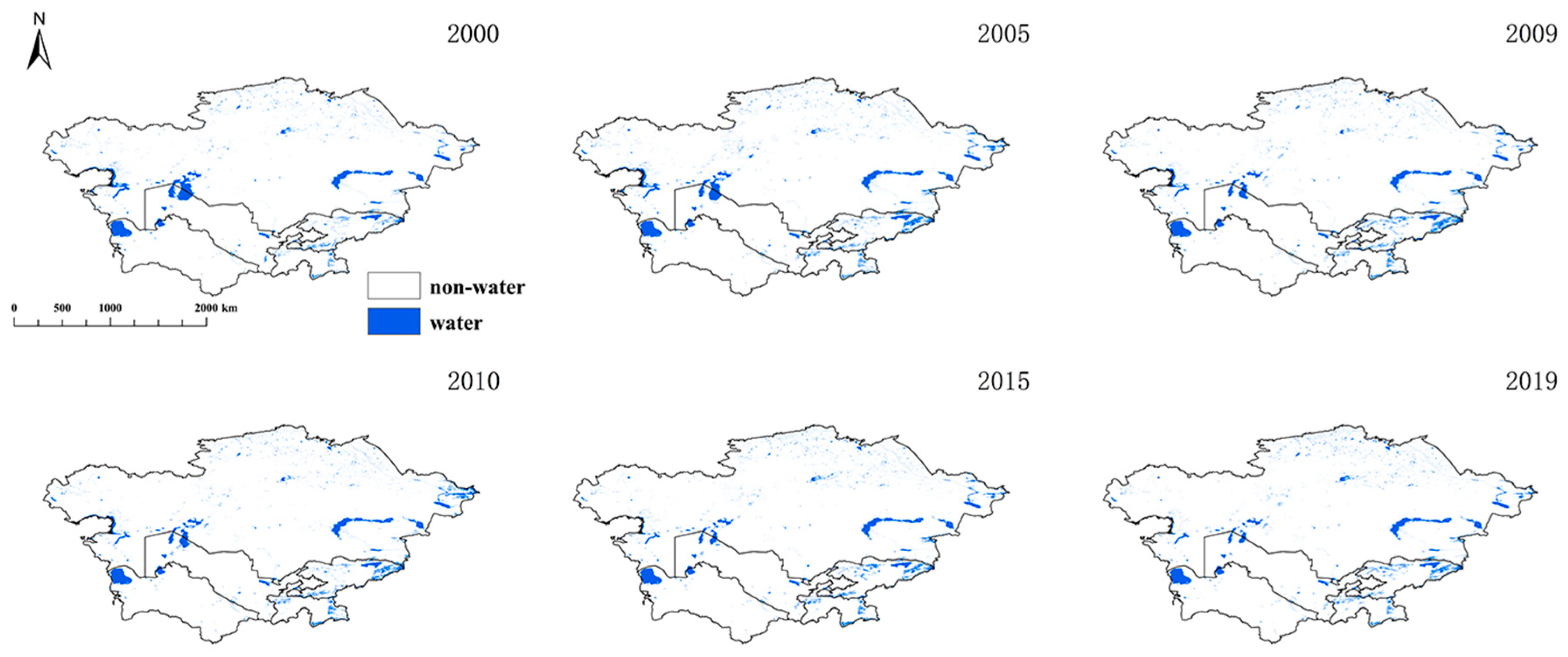
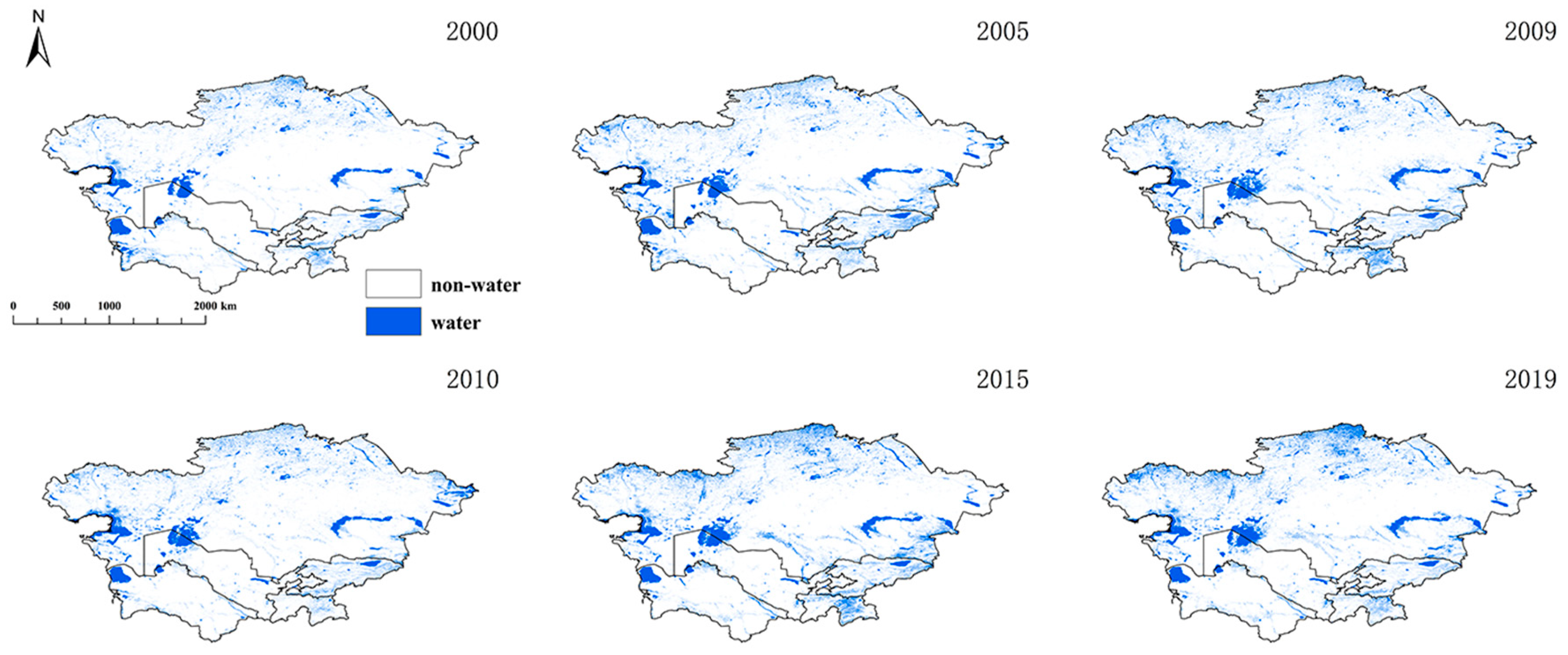
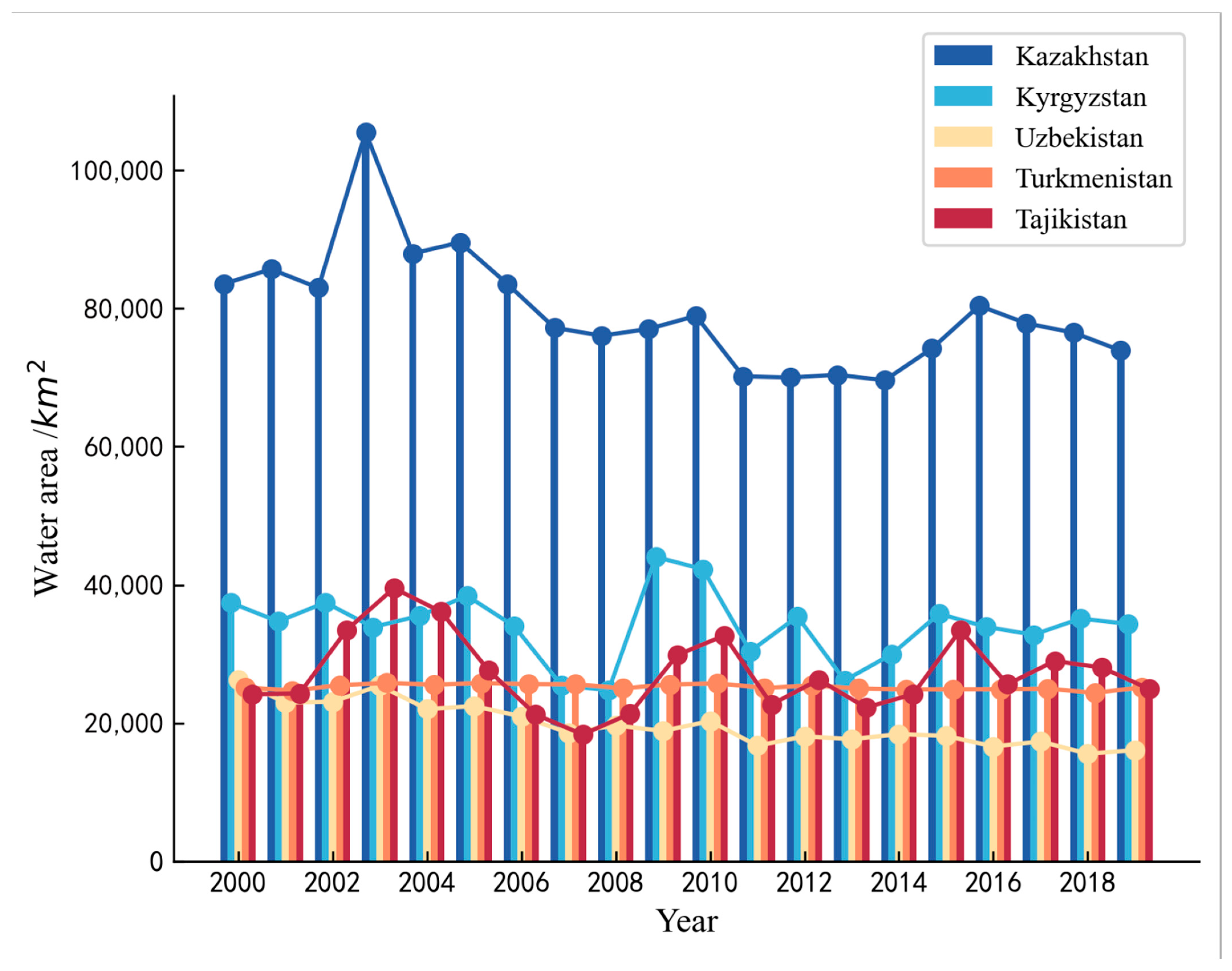
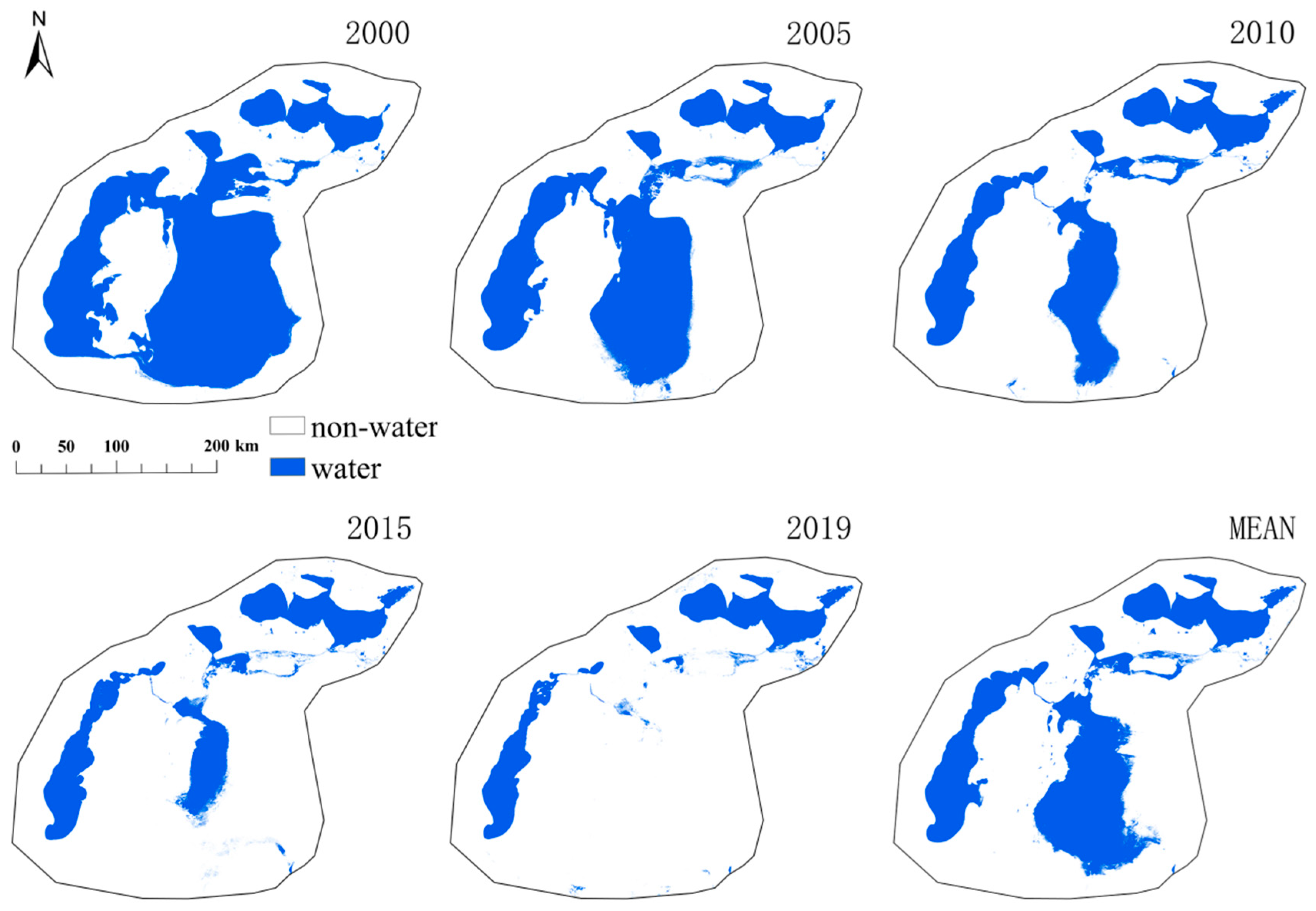

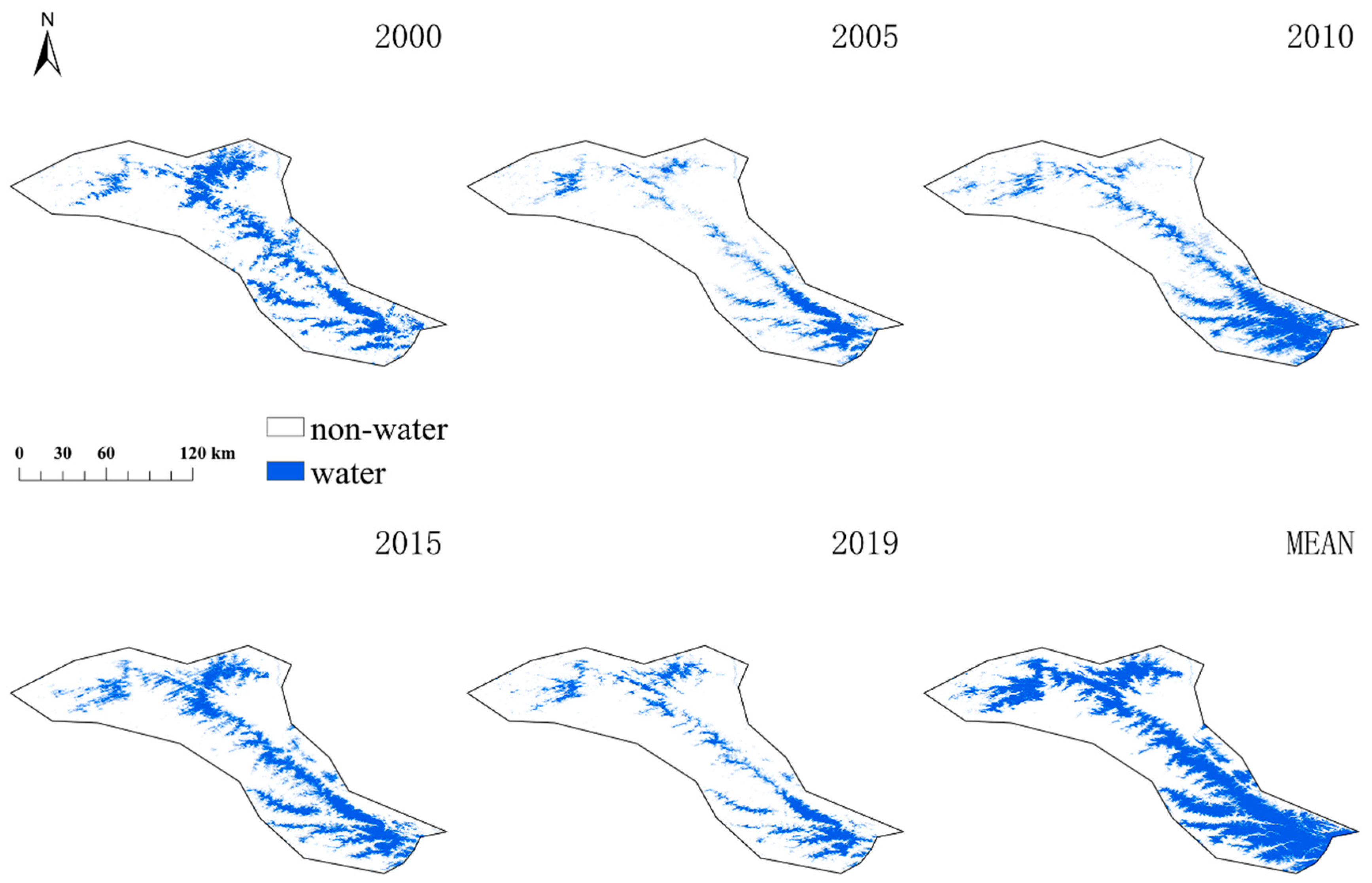
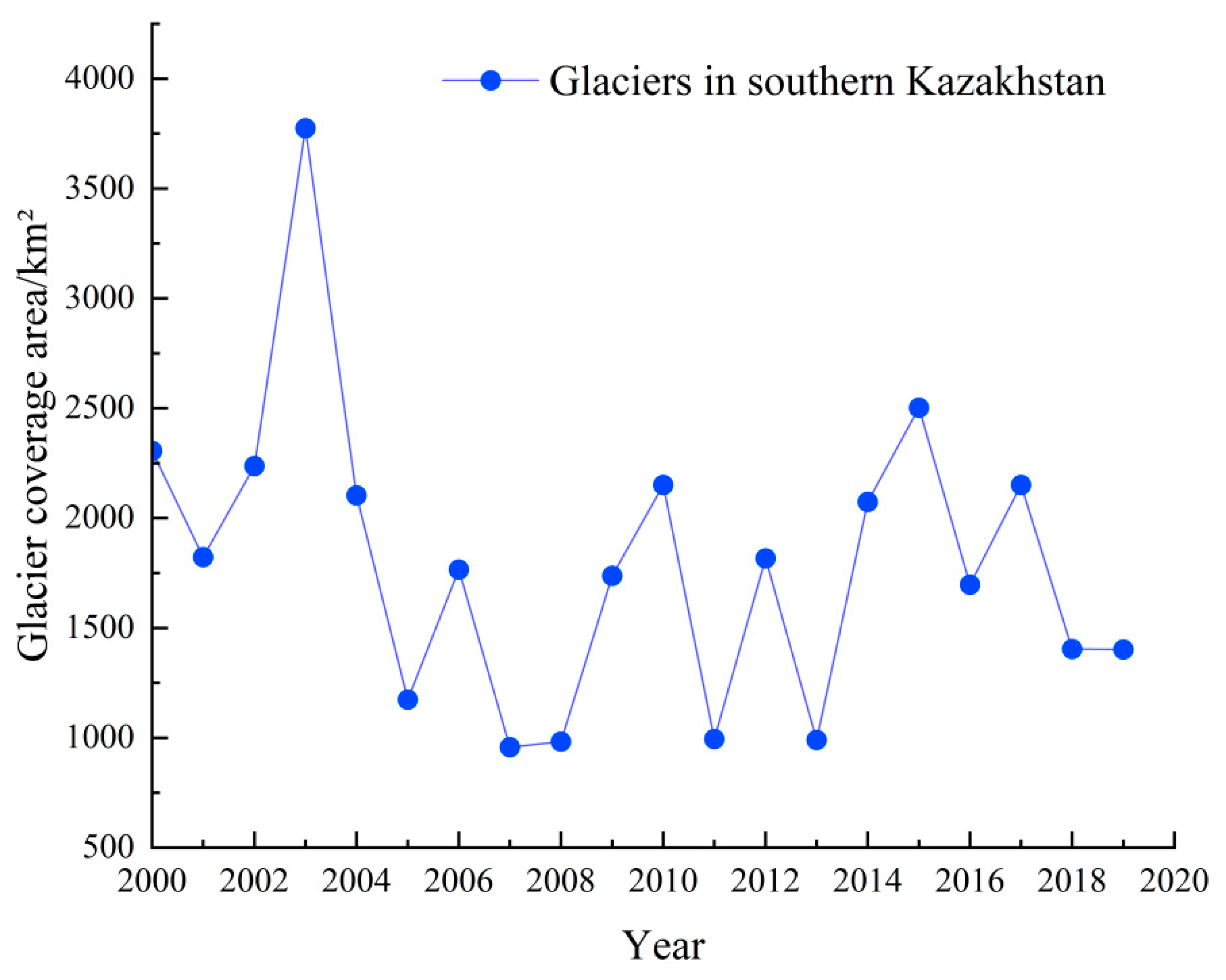
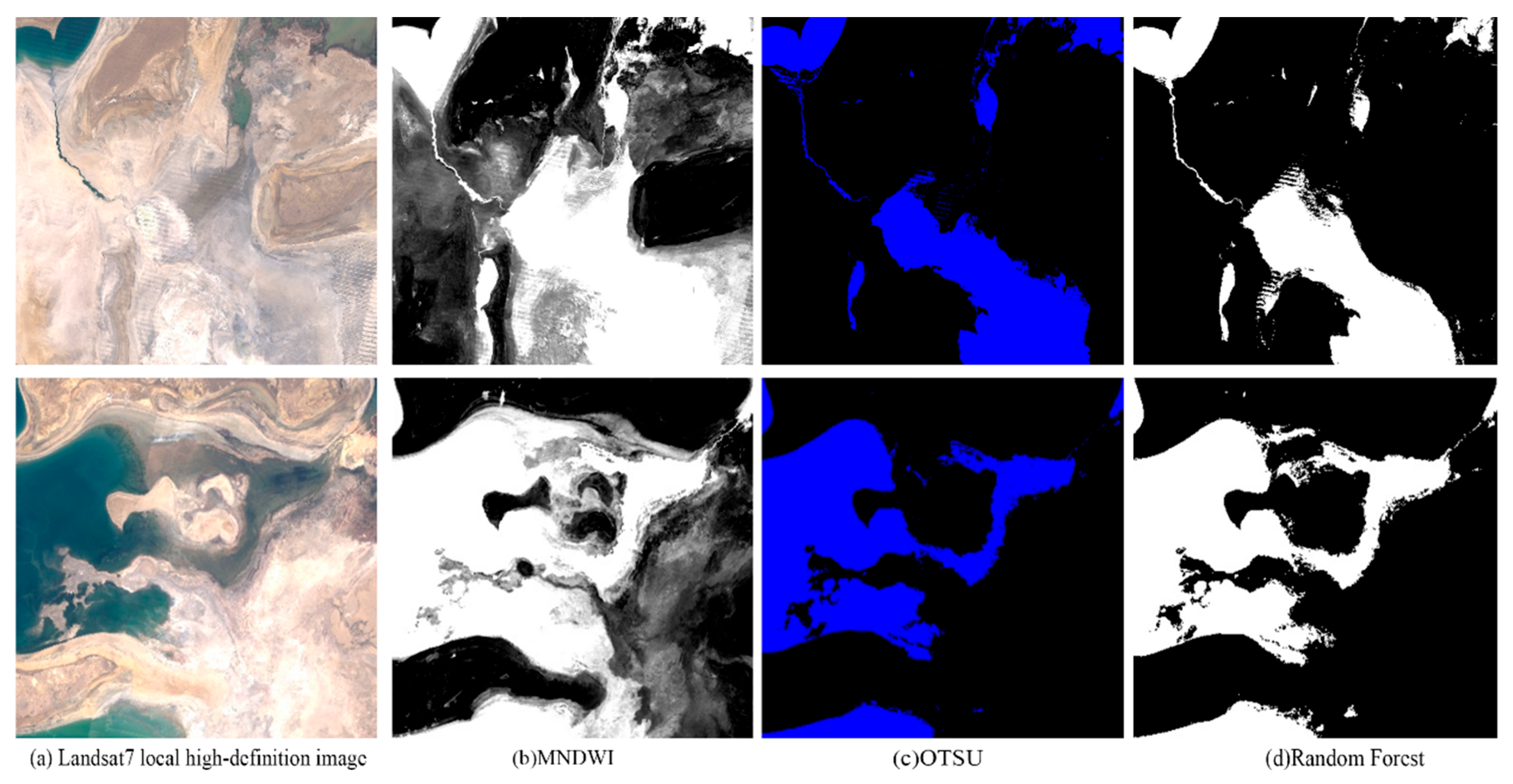
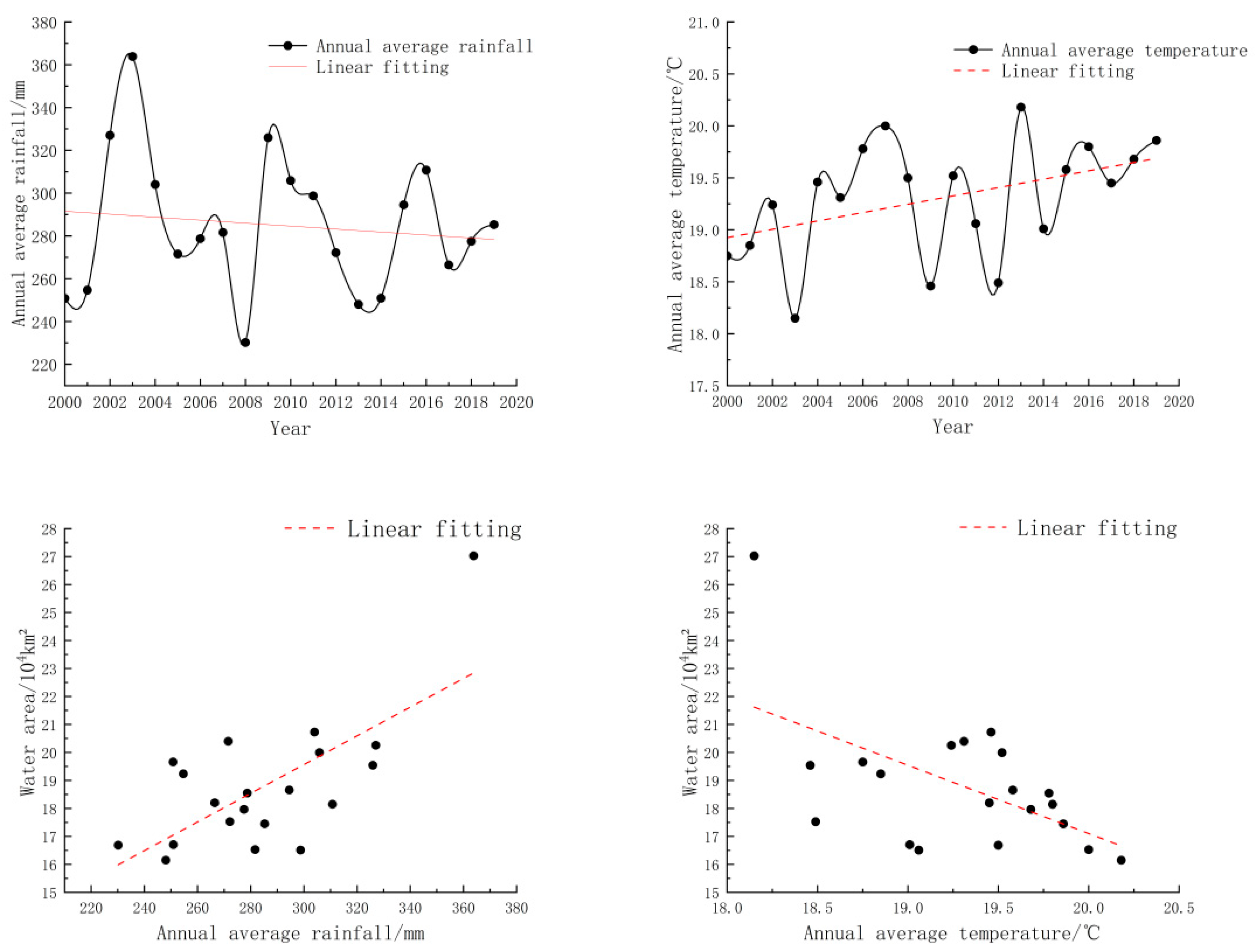
| Year | Water Body Area in Different Years/km2 | ||||
|---|---|---|---|---|---|
| Aral Sea | North Aral Sea | South Aral Sea | East Aral Sea | West Aral Sea | |
| 2000 | 25,722.76 | 2888.48 | 22,843.78 | \ | \ |
| 2003 | 20,576.01 | 2956.46 | 17,619.42 | 12,459.56 | 5157.48 |
| 2005 | 19,563.94 | 2970.82 | 16,593.13 | 11,620.71 | 4971.18 |
| 2010 | 14,326.93 | 3385.83 | 10,940.89 | 7107.82 | 3831.45 |
| 2015 | 9456.32 | 3385.09 | 6071.21 | 2884.92 | 3185.98 |
| 2019 | 7168.68 | 3425.62 | 3741.02 | 1069.87 | 2667.16 |
| MEAN | 16,135.77 | 3168.71 | 12,968.24 | 7028.58 | 3962.65 |
| Year | MNDWI | OTSU | RF | |||
|---|---|---|---|---|---|---|
| Accuracy | Kappa | Accuracy | Kappa | Accuracy | Kappa | |
| 2000 | 0.9853 | 0.9705 | 0.9874 | 0.9743 | 0.9593 | 0.9181 |
| 2001 | 0.9727 | 0.9449 | 0.9552 | 0.9689 | 0.9516 | 0.9032 |
| 2002 | 0.9742 | 0.9477 | 0.9687 | 0.9366 | 0.9574 | 0.9134 |
| 2003 | 0.9371 | 0.8741 | 0.8558 | 0.6964 | 0.9491 | 0.8962 |
| 2004 | 0.9752 | 0.9498 | 0.8779 | 0.7450 | 0.9617 | 0.9215 |
| 2005 | 0.9753 | 0.9501 | 0.9757 | 0.9511 | 0.9586 | 0.9161 |
| 2006 | 0.9637 | 0.9265 | 0.9537 | 0.8930 | 0.9493 | 0.8970 |
| 2007 | 0.9673 | 0.9338 | 0.9457 | 0.8880 | 0.9633 | 0.9263 |
| 2008 | 0.9742 | 0.9476 | 0.7737 | 0.7388 | 0.9487 | 0.8964 |
| 2009 | 0.9653 | 0.9294 | 0.7539 | 0.5220 | 0.9368 | 0.8717 |
| 2010 | 0.9644 | 0.9274 | 0.9775 | 0.9546 | 0.9460 | 0.8900 |
| 2011 | 0.9658 | 0.9307 | 0.9612 | 0.9446 | 0.9373 | 0.8718 |
| 2012 | 0.9678 | 0.9354 | 0.9672 | 0.9341 | 0.9542 | 0.9062 |
| 2013 | 0.9603 | 0.9175 | 0.6516 | 0.4865 | 0.9489 | 0.8970 |
| 2014 | 0.9737 | 0.9466 | 0.8521 | 0.7036 | 0.9565 | 0.9117 |
| 2015 | 0.9844 | 0.9680 | 0.9689 | 0.9347 | 0.9475 | 0.8941 |
| 2016 | 0.9880 | 0.9756 | 0.9784 | 0.9630 | 0.9565 | 0.9122 |
| 2017 | 0.9796 | 0.9576 | 0.9632 | 0.9111 | 0.9662 | 0.9321 |
| 2018 | 0.9741 | 0.9466 | 0.9054 | 0.7814 | 0.9459 | 0.8911 |
| 2019 | 0.9810 | 0.9615 | 0.8864 | 0.7677 | 0.9463 | 0.8916 |
| Mean | 0.9714 | 0.9421 | 0.9080 | 0.8348 | 0.9521 | 0.9029 |
Disclaimer/Publisher’s Note: The statements, opinions and data contained in all publications are solely those of the individual author(s) and contributor(s) and not of MDPI and/or the editor(s). MDPI and/or the editor(s) disclaim responsibility for any injury to people or property resulting from any ideas, methods, instructions or products referred to in the content. |
© 2025 by the authors. Licensee MDPI, Basel, Switzerland. This article is an open access article distributed under the terms and conditions of the Creative Commons Attribution (CC BY) license (https://creativecommons.org/licenses/by/4.0/).
Share and Cite
Chang, K.; Yue, W.; Wang, H.; Tan, K.; Liu, X.; Cao, X.; Chen, W. Research on the Method of Extracting Water Body Information in Central Asia Based on Google Earth Engine. Water 2025, 17, 804. https://doi.org/10.3390/w17060804
Chang K, Yue W, Wang H, Tan K, Liu X, Cao X, Chen W. Research on the Method of Extracting Water Body Information in Central Asia Based on Google Earth Engine. Water. 2025; 17(6):804. https://doi.org/10.3390/w17060804
Chicago/Turabian StyleChang, Kai, Wendie Yue, Hongzhi Wang, Kaijun Tan, Xinyu Liu, Xiaoyi Cao, and Wenqian Chen. 2025. "Research on the Method of Extracting Water Body Information in Central Asia Based on Google Earth Engine" Water 17, no. 6: 804. https://doi.org/10.3390/w17060804
APA StyleChang, K., Yue, W., Wang, H., Tan, K., Liu, X., Cao, X., & Chen, W. (2025). Research on the Method of Extracting Water Body Information in Central Asia Based on Google Earth Engine. Water, 17(6), 804. https://doi.org/10.3390/w17060804





